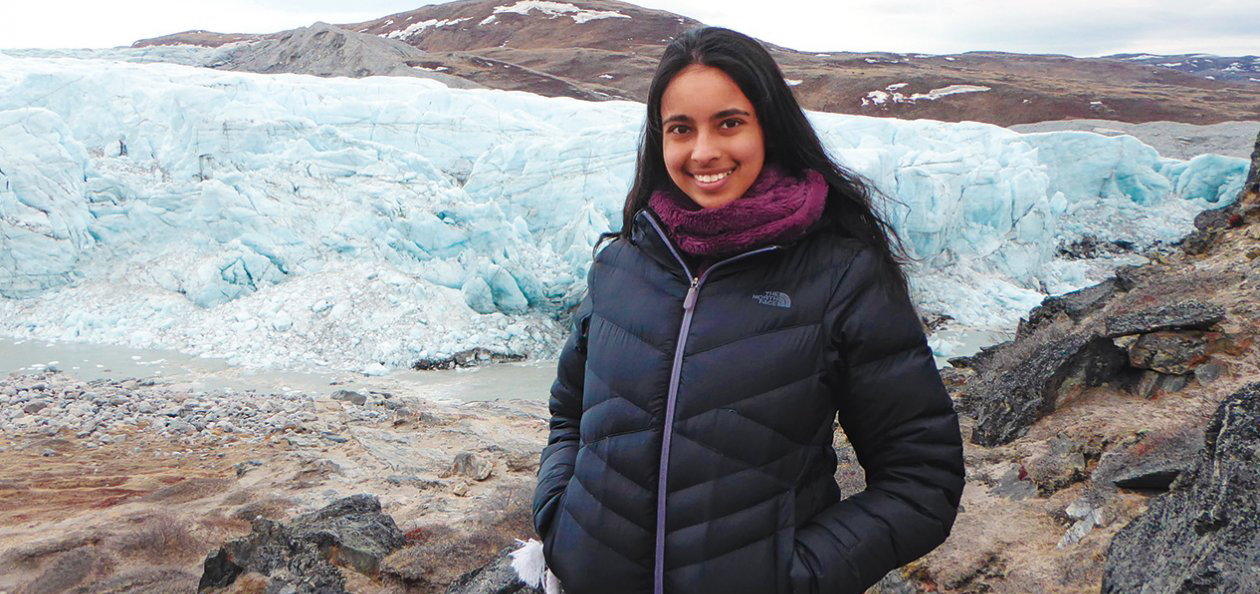
ERL/EAPS Graduate Student Meghana Ranganathan uses math and machine learning to improve how climate predictions are made
FROM MIT SPECTRUM, WINTER 2019:
A SIREN WAILED, PROMPTING MEGHANA RANGANATHAN, AGE 6, TO RUN TO THE CLOSET in the guest room. She was armed with a stack of Calvin and Hobbes books and a glass of water. She closed the door behind her and waited out the tornado. “That would be my setup until I fell asleep in there, and then my mom would move me,” she says.
Ranganathan grew up in Dallas, where tornado watches and warnings happen a couple of times each year. Which means she took to that closet a lot. Once, in high school, she crammed into an office with 20 other students and a teacher for four hours, waiting out three tornadoes circling the area. It was later, in college, that her fear of storms transformed into something else. Ranganathan came to understand that “you can use math to represent the world around you.” In particular, she was taken with mathematical models that predict weather and climate—the very predictions that give the people of Dallas, say, a heads up that a tornado is brewing.
Today, as a graduate student in the Department of Earth, Atmospheric and Planetary Sciences (EAPS) at MIT, Ranganathan is focused on improving how models work. One approach is to meld an imperfect model (built primarily out of equations and assumptions) with an actual dataset (sparse and uncertain as it may be) to bring the model output into stronger alignment with reality. The technique can be “used to better recreate the past,” says Ranganathan, so that the future can be better anticipated. The goal is to apply what she’s learning to models of weather and extreme climate. “The big hurdle is being able to understand what’s going to happen with climate change,” she says. “If we run a climate model for 100 years, what is actually going to happen in 2100?”
Ranganathan has started to apply her theoretical work to a real-world problem: the movement and shape-shifting of ice sheets. Traditionally, researchers run a model of ice flow and compare it to observations of the position and velocity of a glacier over time. Inevitably, discrepancies arise, causing the model to be tuned and tweaked until it more closely mimics reality. But Ranganathan is attempting to enhance and perfect the model by also including the actual satellite data from glaciers in Antarctica.
Should all go well with her work, Ranganathan hopes to improve the certainty around what the future holds. But weather and climate are chaotic systems, making them difficult to predict by definition. One way that Ranganathan is tackling the chaos is through machine learning, where a computer teaches itself with little or no human input. Advised by Sai Ravela, an EAPS principal research scientist with a computer science background, she is using neural networks—a machine learning model roughly based on the connections in the human brain—to help tackle the vast amounts of data she’s dealing with. The hope is to speed up the effort and make it more accurate.
Ranganathan’s graduate work at MIT is possible because of financial support, including from the Callahan Dee Fellowship Fund. “The people who dedicate their resources to fellowships are enabling all of this amazing work that we do,” she says. “It’s what makes it possible for me to be here. I mean, the fellowship has been everything.”
Despite the imminent danger facing this planet, Ranganathan no longer runs to the closet to seek cover. Instead, she surrounds herself with people who help her make sense of it. There are the researchers in her department dedicating their lives to weather and climate “to help make the world a better place.” They give her hope. And there are the residents of polar regions themselves—people Ranganathan is already speaking with (in Greenland, for instance) to understand the full range of a community’s experience with climate change. They give her a reality check.
Last fall, the Intergovernmental Panel on Climate Change released a report stating that without action, the worst effects of a changing climate will occur within the next one to three decades. Which means: the siren is wailing. And Meghana Ranganathan and her colleagues are doing all they can to respond.
Cover image: Ranganathan spent a week in Kangerlussuaq, Greenland, in 2016 as an undergraduate studying environmental science. Photo: Courtesy of Meghana Ranganathan.